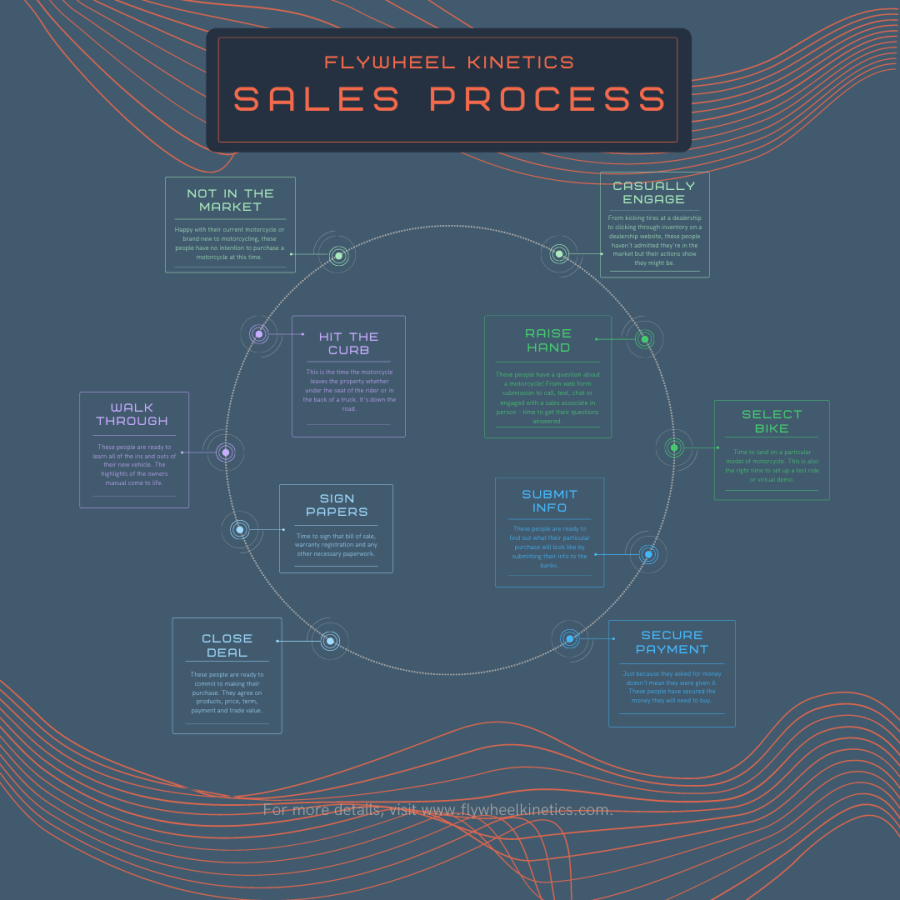Remember that “Observable Universe” video from way back in the day? Where you zoomed out from...
Ditch Your Sales Process
In a recent Mark Rodgers video for DealerNews Magazine, the industry thought-leader posed his ideas on what he calls the “Purchase Powertrain”. I’d like to challenge you to take it a step further by completely ditching your sales process..
In the video he gives the highlights of a customer’s “Purchase Process” when buying a motorcycle. While I can appreciate how he has tied it back in to motorcycling with his clever parallel, it lacks a little… implementation.
Most dealerships are currently running the “Lemco”, the “Martin Method”, or some variation of the 6 to 15 step sales process that has been bouncing around the presentations of just about every sales trainer in the industry for the last 50 years. What all of these sales processes have in common is a list of actions the sales person is expected to take with a customer on the showroom floor to be awarded a vehicle sale. These are expectations set down from sales tower managers to the sales associate. Greet, probe, present, sit-on, sit-down, etc. We all know the drill.
What all of these sales processes also have in common is a lack of consideration for what the customer wants not to mention what that customer does before they hit that showroom floor. It might be time to take another look at that age-old “proven” sales process and look at things from the customer’s point-of-view. If for no other reason than to know what to do next with a customer.
Let’s say you’re a Sales Manager and you look around your showroom floor to see one of your sales associates sitting with a customer at a table filling out a credit application. You can expect that your sales associate has greeted that customer, gotten to know them, presented them with a motorcycle and is now in the process of collecting their information. You know what is next for that sales associate to do – according to your sales process. You can measure that associate’s progress through your sales pipeline and have some pretty solid metrics on what percentage of those deals will close into an actual sale.
But what of the customer that has never been in your shop, done all of their research online, picked a bike from your online inventory and filled out a credit application on your website. Sound familiar? They haven’t stepped foot in your store. They haven’t talked to a sales associate. Where are they in your sales process? Is it even a deal? What if they request a remote delivery? How do you…do that?
I offer to you… a new type of sales process. A modern one. A purchase process. One every customer goes through – online and IRL alike. Their experience is the focus. It puts every customer and every deal on the same playing field, in your pipeline and on your sales forecast. And keeps you from prioritizing the “tire kicker” on your showroom floor over the hot online leads sitting in your inbox.

Instead of visualizing this as a funnel – like most sales processes – think of it as a circle. Better yet, think of it as a flywheel. Every customer exists somewhere on this spectrum. Being able to “bucket” your customers according to where they are in this process towards purchase allows you to identify the next step they will WANT to take. The phase gates are easy to measure as it’s either an action the customer has taken or not – more so than your sales associate’s interpretation of what constitutes a “Sit-On”. These steps apply to customers on your showroom floor just as well as they apply to customers sitting on their couches at 2am surfing your inventory.
When you are able to bucket your customers, your sales team becomes more effective – but so does your marketing. If a customer just completed a credit application, your team would know the next step the customer wants is to know what this going to cost them. You’d show them a price, a payment, terms… and ask for a commitment to buy. Same could go for marketing. If your marketing team was able to identify a person as “Casually Engaging” with your inventory they could know that it’s time to nudge that customer towards “raising their hand” by offering up specific products they might be interested in based on their activity AND all of the different channels they can use to communicate with you.
Your customers are looking to interact with your dealership team in more ways than ever. This way of thinking about your customer doesn’t give more or less priority to the customers that wish to interact in-person, over the phone or through Facebook Messenger. It’s all the same to them, so why isn’t it to you?
Dealerships in the days post-COVID have been scrambling to try to work “digital retailing” and “remote delivery” into their sales process. The problem is that it just doesn’t fit. (Where is the point in the process where you print the state’s form on the Okidata Microline?) If you are serious about selling to customers – who are now extremely comfortable completing large purchase transactions from the comfort of their homes – using digital retailing it’s time to consider a purchase process that works for everyone.
So are you ready to flip your sales process inside out and rebuild from the customer’s perspective?




